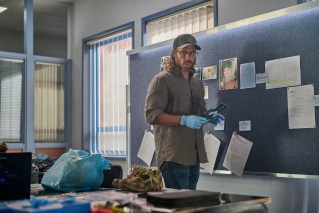The Block 2016: contestants face stinky, old location


The contestants have a daunting task ahead of them. Channel Nine
The Port Melbourne site of Channel Nine’s The Block caused quite a stink in its heyday.
The building was the administration centre for one of Melbourne’s most famous businesses – J. Kitchen’s soap and candle makers (later merged to become Unilever) – and butchers used to drop their left-over scraps and bones off at the plant on site before heading to the nearby abattoir to buy more supplies.
In the early days, their soap and candles were made from boiling a stinking mix of fats and oils and the business had already been forced to move from South Melbourne to this site in 1858 – as a “noxious trade” – because of the stench it created.
By 1923, when the administration centre was built, soap-making methods on the site had improved and J Kitchen and Co was one of Melbourne’s biggest industrial manufacturers and regarded as one of the best employers in the country.
The Port Melbourne site covered 117 acres and employed 1400 people.

The exterior of the massive property.
Spacious, airy and designed in Neo-Classical style to capture natural light, this building was renowned as one of the best in the Commonwealth for employees to work in.
Revolving storm doors opened to a mosaic-tiled floor in the vestibule featuring the company monogram and interior fittings were of the highest quality, with doors of polished maple and plate glass.
The second of the three floors contained a spacious hall for social occasions where up to 700 people danced on a Kauri wood floor.

A buzzing 1400 people worked on the site in its heyday.
But that was then. By the time the ‘Blockheads’ arrived, all that was left was the vandalised, wrecked interior and an imposing, heritage-protected exterior.
No wonder the Blockheads looked stunned on arrival.
The building was vacated in the 1990s and sat idle as the land around it was sold off for apartments in an increasingly trendy suburb. A couple of years ago, a consortium attempted to raise funds to renovate it for a new school but they were defeated by the amount of money they needed.
Enter Channel Nine, with a $5 million dollar cheque to buy the building and willing labour, a bank account and sponsors to do transform it into six apartments.

This will be the biggest build the series has ever attempted.
It is the largest build the series has ever attempted – a couple of tennis courts bigger than the previous biggest, The Glass House a couple of years ago.
And those two little words: “heritage protected”, are another first and add a whole new layer of complexity to any build – though the heritage report notes it’s the exterior of the building which is of most note, while the inside was largely generic and, in parts, beyond repair.
But there’s pressure on the contestants to stay true to the Art Deco era as they build their apartments and it’s going to form part of the judging criteria as the work unfolds.
On Sunday the story of the 12-week process begins on Channel Nine. The contestants arrive – bright eyed and full of enthusiasm – and, using clever ‘flash forwards instead of ‘flashbacks, we get a taste of how their optimism plays out.
Perhaps even more importantly than how they fare is whether their work does justice to one of Melbourne’s iconic design and industrial success stories – or whether they just cause another stink in the neighbourhood.
The new season of The Block starts Sunday, August 21, at 7.00pm.








